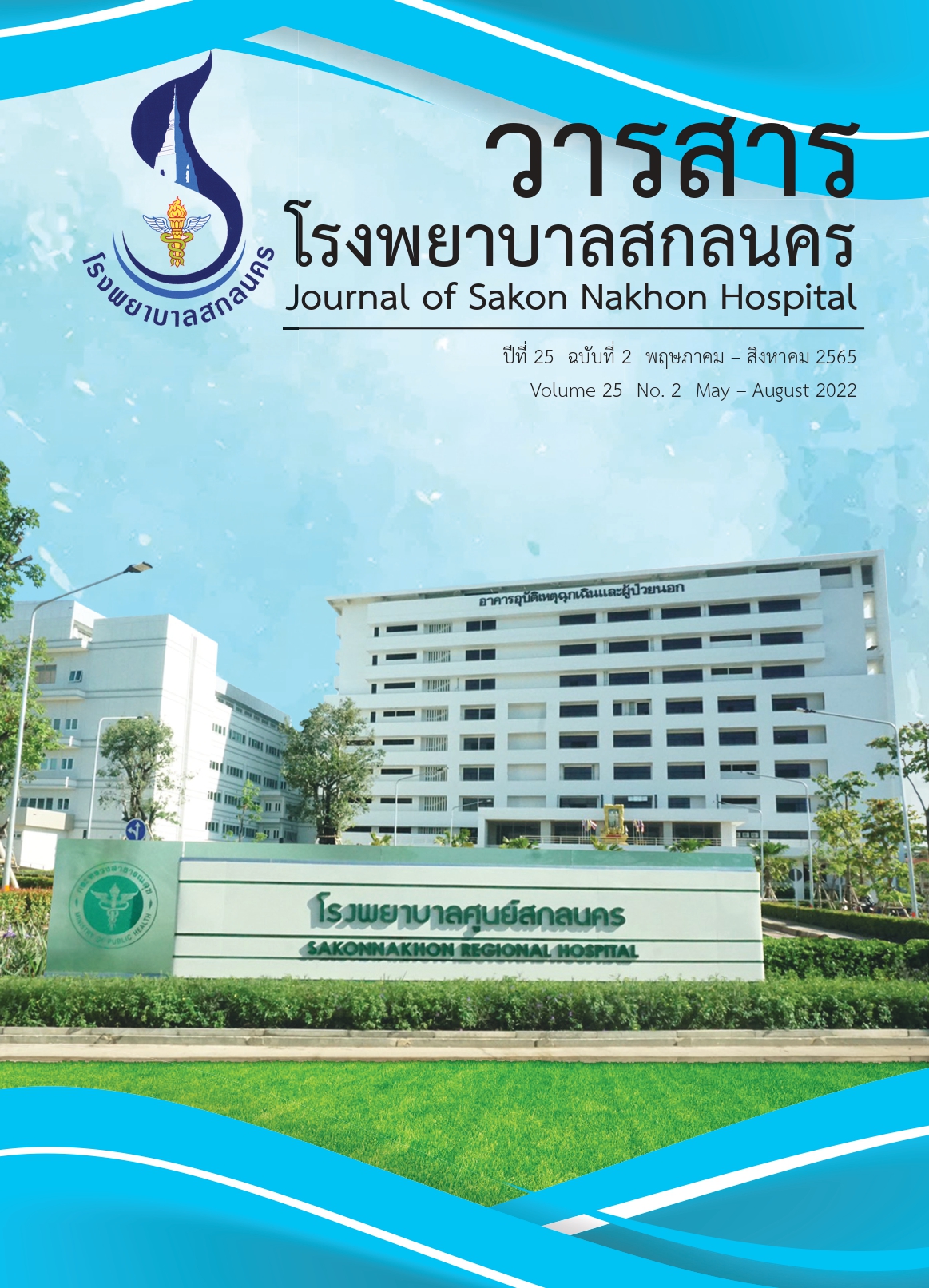การประเมินหลักสูตรพยาบาลศาสตรบัณฑิต (หลักสูตรปรับปรุง พ.ศ. 2560) วิทยาลัยพยาบาลบรมราชชนนี อุดรธานี
คำสำคัญ:
การประเมินหลักสูตร, หลักสูตรพยาบาลศาสตรบัณฑิต, วิทยาลัยพยาบาลบรมราชชนนีบทคัดย่อ
การวิจัยเชิงบรรยายมีวัตถุประสงค์เพื่อประเมินความคิดเห็นต่อหลักสูตรพยาบาลศาสตรบัณฑิต (หลักสูตร ปรับปรุง พ.ศ. 2560) วิทยาลัยพยาบาลบรมราชชนนี อุดรธานี กลุ่มตัวอย่างประกอบด้วย อาจารย์ผู้รับผิดชอบหลักสูตร จำนวน 7 คน อาจารย์ประจำหลักสูตร จำนวน 58 คน นักศึกษาพยาบาลศาสตร์ ชั้นปีที่ 4 รุ่น 27 จำนวน 116 คน สำเร็จการศึกษาในปีการศึกษา 2564 ดำเนินการรวบรวมข้อมูลในเดือนธันวาคม พ.ศ. 2564 พยาบาลพี่เลี้ยงในแหล่ง ฝึกภาคปฏิบัติ จำนวน 10 คน และผู้ใช้บัณฑิต จำนวน 10 คน เครื่องมือที่ใช้ในการรวบรวมข้อมูลประกอบด้วย แบบสอบถามความคิดเห็นต่อหลักสูตรพยาบาลศาสตรบัณฑิต (หลักสูตรปรับปรุง พ.ศ. 2560) วิทยาลัยพยาบาลบรม ราชชนนี อุดรธานี และคำถามการสนทนากลุ่ม ตรวจสอบความตรงของเครื่องมือโดยผู้ทรงคุณวุฒิ จำนวน 3 คน และ หาความเชื่อมั่นโดยใช้สูตรสัมประสิทธิ์อัลฟาของครอนบราค ได้ค่าความเชื่อมั่นเท่ากับ 0.85 วิเคราะห์ข้อมูลโดย คำนวณค่าเฉลี่ย ส่วนเบี่ยงเบนมาตรฐาน และการวิเคราะห์เนื้อหา
ผลการวิจัย พบว่า อาจารย์ผู้รับผิดชอบหลักสูตร อาจารย์ประจำหลักสูตรและนักศึกษา มีความคิดเห็นเฉลี่ย โดย รวม ด้านบริบทของหลักสูตรอยู่ในระดับมากและมากที่สุด ( = 4.51, 4.27 และ 4.14, S.D. = 0.48, 0.48 และ 0.52 ตามลำดับ) ด้านปัจจัยนำเข้าอยู่ในระดับมาก (
= 4.33, 4.21 และ 4.12, S.D. = 0.48, 0.53 และ 0.57 ตาม ลำดับ) ด้านกระบวนการอยู่ในระดับมากและมากที่สุด (
= 4.58, 4.15 และ 4.13, S.D. = 0.48, 0.61 และ 0.62 ตามลำดับ) และด้านผลลัพธ์ของหลักสูตรอยู่ในระดับมาก (
= 4.45, 4.17 และ 4.15, S.D. = 0.56, 0.59 และ 0.61 ตามลำดับ)
ผลการวิจัยครั้งนี้สามารถนำไปใช้เป็นข้อมูลพื้นฐานในการพัฒนาหลักสูตรพยาบาลศาสตรบัณฑิตต่อไป และควร มีติดตามผลลัพธ์ของหลักสูตรโดยการติดตามประเมินคุณภาพบัณฑิตในระยาวภายหลังการสำเร็จการศึกษาเพื่อติดตาม สมรรถนะบัณฑิต
เอกสารอ้างอิง
ทัศนัย ประยูรหงษ์และไพบูลย์ดาวสดใส. การศึกษางานและออกแบบงาน ระบบบริการจ่ายยาผู้ป่วยนอกโรงพยาบาลพิมาย นครราชสีมา. ว. เภสัชศาสตร์อีสาน 2551;4(2):24–35.
ธิดา นิงสานนท์และคณะ. กรอบงานพื้นฐานระบบยา. กรุงเทพฯ: สมาคมเภสัชกรรมโรงพยาบาล; 2563.
กรแก้ว เมธีศิริวัฒน์และคัคนางค์ไชยศิริ. การพัฒนางานบริการห้องจ่ายยาผู้ป่วยนอก ณ โรงพยาบาลจุฬาลงกรณ์[ปริญญาเภสัชศาสตร์บัณฑิต]. กรุงเทพฯ: มหาวิทยาลัยมหิดล; 2550.
อินทิรา ช่อไชยกุล. ประสิทธิผลของระบบคิวจ่ายยาแยกประเภทตามกลุ่มห้องตรวจ ห้องจ่ายยาผู้ป่วยนอกโรงพยาบาลลำปาง. ว. วิจัยพัฒนาระบบงานสาธารณสุขแพร่2562;9(8).
ใจรักษ์ยอดมงคล. การปรับปรุงประสิทธิภาพด้านการรอรับยาผู้ป่วยนอก โรงพยาบาลมหาวิทยาลัย [ปริญญาวิทยาศาสตรมหาบัณฑิต]. กรุงเทพฯ: จุฬาลงกรณ์มหาวิทยาลัย; 2559.
Susanto AN, Chalidyanto D. Waiting time and satisfaction of outpatient in the pharmacy section. EurAsian Journal of Bio Sciences 2020;14(2):3263–3266.
ประคอง กรรณสูต. สถิติเพื่อการวิจัยทางพฤติกรรมศาสตร์. พิมพ์ครั้งที่3. กรุงเทพฯ: สำนักพิมพ์แห่งจุฬาลงกรณ์มหาวิทยาลัย; 2542.
สุขใจ ปานทอง. การวิเคราะห์งานบริการเภสัชกรรมโรงพยาบาล: กรณีศึกษา ในงานบริการจ่ายยาผู้ป่วยนอกโรงพยาบาลบ้านไผ่ (ม.ป.ท). ขอนแก่น: มหาวิทยาลัยขอนแก่น; 2548.
วิภาวี ชาดิษฐ์. ความพึงพอใจของผู้มารับบริการต่อคุณภาพบริการแผนกจ่ายยาผู้ป่วยนอก โรงพยาบาลเจ้าพระยายมราช จังหวัดสุพรรณบุรี. Veridian E–Journal, Silpakorn University (Humanities, Social Sciences and arts 2560;10(1):161–177.
จุฑามาศ เรืองจุ้ย. การพัฒนางานบริการจ่ายยาผู้ป่วยนอก โรงพยาบาลกระทุ่มแบน [ปริญญาเภสัชศาสตร์บัณฑิต]. นครปฐม: มหาวิทยาลัยศิลปากร; 2555.
เจริญศรีชินวรากร. การปรับลดระยะเวลาการให้บริการจ่ายยาผู้ป่วยนอก โรงพยาบาลสมเด็จพระพุทธเลิศหล้า. ว. วิชาการสาธารณสุข 2559;25(4):664–672.
ดาวน์โหลด
เผยแพร่แล้ว
รูปแบบการอ้างอิง
ฉบับ
ประเภทบทความ
สัญญาอนุญาต
บทความที่ตีพิมพ์ถือว่าเป็นลิขสิทธิ์ของวารสารโรงพยาบาลสกลนคร การคัดลอกเพื่อพัฒนาเชิงวิชาการต้องได้รับการอ้างอิงอย่างถูกต้อง






